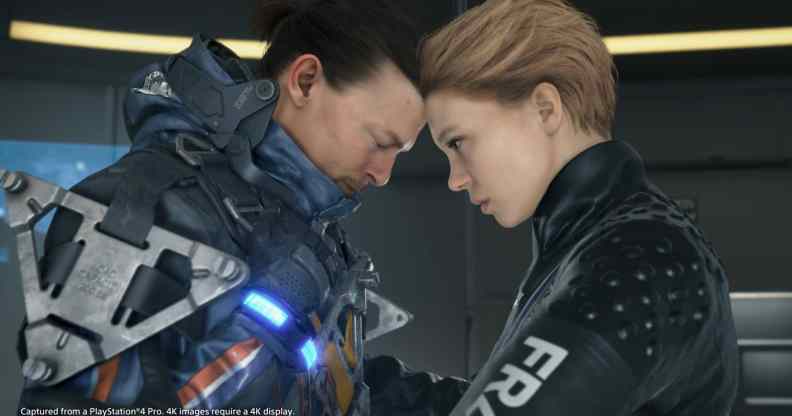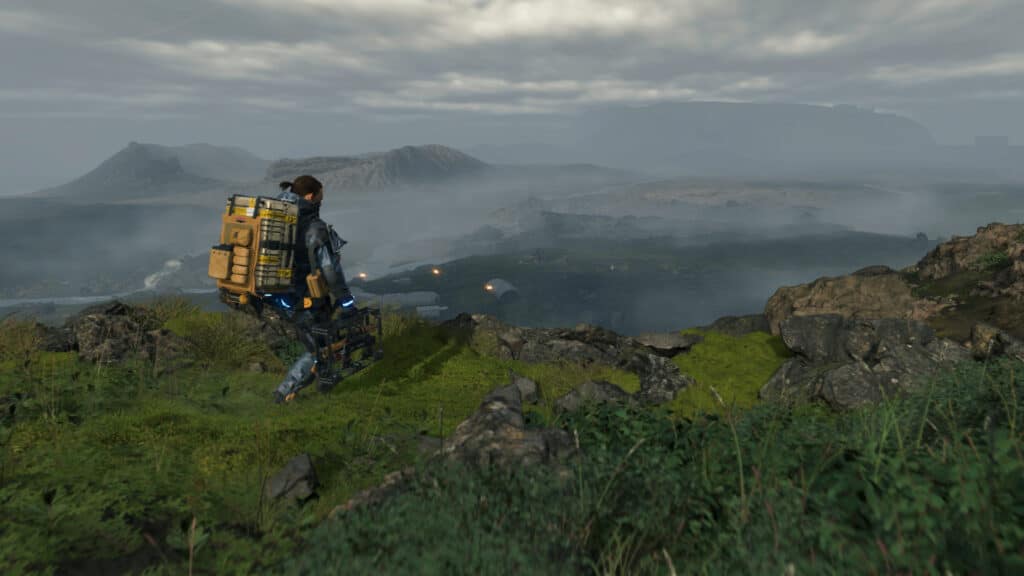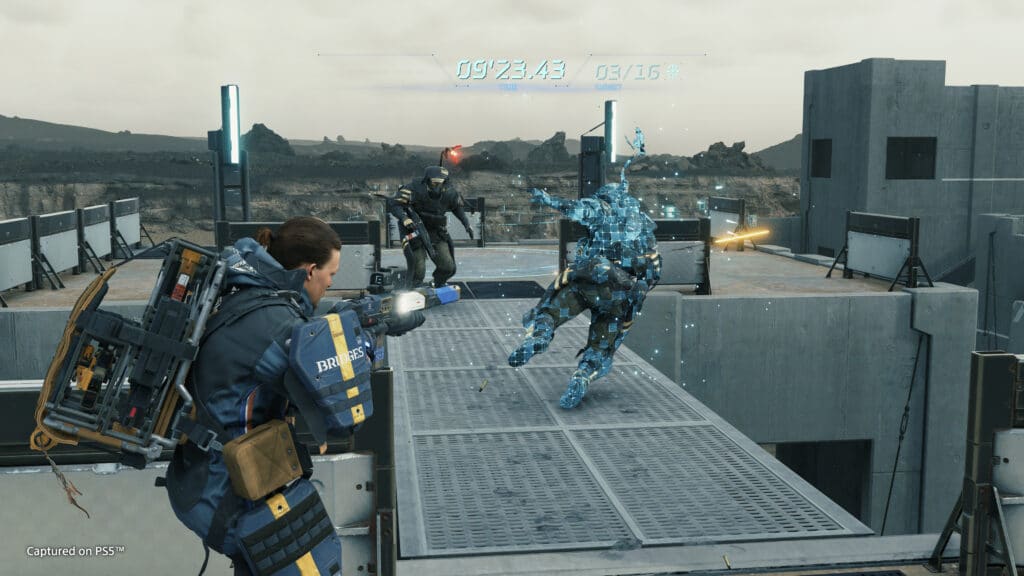Death Stranding, even in Director’s Cut, is as incomprehensible and pretentious as ever

Death Stranding. (Sony)
“Don’t be so serious,” goes the song at the opening of Death Stranding. If only the game listened.
Metal Gear Solid creator Hideo Kojima’s PlayStation exclusive is a bleak meditation on life and death that’s melancholic to an extreme.
But it’s also a game where you create grenades out of urine, use screaming babies to make ghostly beings visible, and defeat ridiculous, over-the-top bosses like maniacal men from another dimension and giant whales.
In short, it’s typical Kojima, with a tone that shifts wildly from weirdness to sombre to silliness. The result is a game that looks pretty – especially this Director’s Cut version on PlayStation 5 – but is a narrative mess.
Indeed, Director’s Cut implies some sort of edit. But instead the game is so crammed full of ideas it feels incomprehensible. It’s style over pretentious substance.
Thematically, the plot has some intriguing ideas. It’s a collision of life, death and the afterlife as mankind struggles to survive in the aftermath of a cataclysmic event: the titular Death Stranding. And it’s an exploration of the human need for connection, even in the darkest of times. The greatest connection of all is that between a parent and their child.
The problem is in the way the story is told. Death Stranding thrives on WTF moments, relying on shock value to intrigue the player and keep them guessing. But the player has to buy into the weirdness from the beginning, which is asking a lot when so little information is given out.
Much of the backstory and context is hidden away in data archives and the game seems to purposely confuse the player to keep them on the back foot. It’s not helped by a heavy-handed script full of sci-fi and philosophical hokum that has every character speaking in metaphors and acronyms, and occasionally swings into laughably bad.
As if to make up for this, the game’s ending is a sudden deluge of story that does make a kind of sense but over-explains and leaves little room for subtlety.

Death Stranding. (Sony)
Unfortunately, between any intrigue of story beats, there’s a video game to play.
Story and equipment alike are eked out over a long period, meaning the game progresses at a snail’s pace, which is a fitting image for a man carrying his life around on his back. Protagonist Sam is little more than an isolated errand boy, carrying cargo from one place to another across the rugged Icelandic terrain of this post-apocalyptic America.
Death Stranding makes gameplay out of elements we take for granted in other games: inventory management and climbing. Pile up resources and packages unbalanced and Sam will topple over and trip on the smallest of rocks. Traversing long distances requires making use of ladders and bridges and, later, ziplines and newly built roads. Much of the game is spent simply hiking from point A to point B and not much happens along the way.
There are two types of enemies you’ll stumble upon: human terrorists and BTs. The former will hunt you down but cannot be killed for…story reasons. The latter are invisible apparitions requiring constant scanning, which can make for frustrating encounters – especially when they morph into (admittedly fantastically designed) creatures that interrupt your journey. Eventually you’ll gather a variety of methods of dispatching enemies, but initially combat is a nuisance to be skirted around and avoided.
If walking is dull, there are at least vehicles to drive to ease the pain. The handling is dire, however, meaning walking is often a simpler and more direct option despite the longer and longer distances. Roads can be built, but this requires a tonne of resources until the endgame.
The roads do feed into the game’s most genius feature: building an infrastructure. Tying into the theme of connection, playing online provides asynchronous access to the utilities left behind by other players who can collectively put resources towards roads and bridges. It creates a metagame outside of the main story that ensures completing deliveries gradually becomes oddly satisfying as you amass meaningless likes and accolades in a twist on social media.

Death Stranding. (Sony)
What’s more, the game was originally released on PS4 pre-pandemic. Since then, that need for human connection has only become more pertinent as we’ve struggled to meet with loved ones and have been confined to our homes like bunkers.
It’s an unexpectedly poignant parallel for this re-release of the game, though it hardly provides escapism. In Death Stranding everything is a struggle, with even the simplest elements made difficult. And that’s the point. It’s through overcoming struggles that human connection is worthwhile.
The Director’s Cut version does alleviate some of that struggle with some extra items and weapons. Plus it adds in new features like a shooting range, a racing circuit, and underground stealth sections. None of these drastically change the experience and all are almost entirely optional – it’s just another example of Kojima continuing to overstuff his game. It does at least look stunning and runs at a smooth frame rate. This is certainly the definitive way to play the game.
Ultimately, though, Death Stranding doesn’t do enough emotionally to warrant its struggles. For a game about connection, there’s a distinct lack of feeling or chemistry between its star-studded cast, which leaves the whole experience feeling deathly cold.
It’s the music that does the emotional heavy-lifting here, pun intended. Alongside an atmospheric score by Ludvig Forssell, songs from artists like Low Roar, Au/Ra and CHVRCHES play intermittently to punctuate the journey like sunbeams through a cloud of grey. These songs hold together a tangle of confusing ideas in what is an incredibly divisive – and frequently miserable – experience.
The game struggles under the weight of its own ambition just as Sam struggles to carry his cargo. He slowly crawls up the side of a mountain through torrential rain before stumbling to the ground, packages cascading behind him. There’s seemingly no end to this laborious slog.
But then he reaches the peak. The rain parts; the sun emerges. Wistful music plays. And finally, you can enjoy the view.
3 / 5
Death Stranding Director’s Cut is available on PlayStation 5 from 24 September.
For more gaming news, follow Gaymeo on Facebook and Twitter. You can also email us with any news or tips on [email protected]

